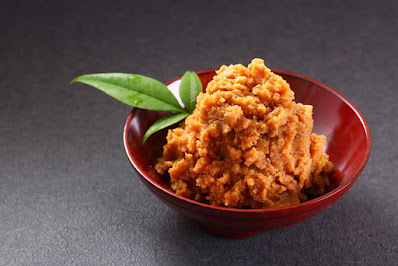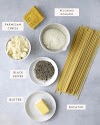 |
| Koji |
Soy sauce, miso, sake, mirin, dried bonito, and bonito dashi stock are all made from koji, which is also the mother of mirin. Isn't it amazing?
Who is Koji?
Koji is a type of Aspergillus oryzae, which is a type of fungus that is used for a number of different things in the kitchen. These things include making alcoholic beverages like sake or shch and useful condiments like miso, mirin, and shyu (soy sauce).
When added to other base ingredients like soybeans, rice, or wheat grains like barley, koji kickstarts the fermentation process in the same way that yeast starters do in bread making. Koji acts as a curing agent in the production of charcuterie when applied to proteins. Starches and proteins are transformed into amino acids and sugars by the enzymes found in koji molds, such as amylase and glutamate. The flavors that result are what define umami: sweet, flavorful, pungent, with a hint of satisfying funk.
Other molds that belong to the same bacterial family as Koji can also be used; For instance, miso and shyu can also be made with Aspergillus sojae as opposed to Aspergillus oryzae.
 |
| What Is Koji? | 5 Common Uses for Koji |
What Is Koji? |
5 Common Uses for Koji
Mold, also known as the "national fungus" of Japan, is a key part of the koji plant's Jump To Section •
What is koji?
• Five Common Uses for Koji
• Video
. Related Recipes
What Is Koji?
Koji is a type of Aspergillus oryzae, which is a type of fungus that is used for a number of different things in the kitchen. These things include making alcoholic beverages like sake or shch and useful condiments like miso, mirin, and shyu (soy sauce).
When added to other base ingredients like soybeans, rice, or wheat grains like barley, koji kickstarts the fermentation process in the same way that yeast starters do in bread making. Koji acts as a curing agent in the production of charcuterie when applied to proteins. Starches and proteins are transformed into amino acids and sugars by the enzymes found in koji molds, such as amylase and glutamate. The flavors that result are what define umami: sweet, appetizing, pungent, with a suggestion of
5 Normal Koji Uses
Koji rice — steamed rice immunized with koji shape and permitted to age for a little more than two days — goes about as a starter for the majority matured food varieties in customary Japanese cooking. Notwithstanding rice, koji is additionally ordinarily utilized on grain grains and yam and can be bought all things considered Asian supermarkets.
• 1. Drinks containing alcohol: In brewed sake, distilled shch, and Okinawa-style awamori, various koji strains, such as white, yellow, and black koji, are used as the fermenting agent to impart distinct flavors. Amazake, a naturally sweet beverage with low alcohol content that can also be eaten as a porridge-like dessert, contains it as the main ingredient.
• 2. Condiments for cooking: The enzyme activity of koji is responsible for the production of rice vinegar and mirin, a sweet cooking wine. Shch and short-grain mochigome sweet rice are combined with koji in mirin, and yeast is added to the converted sugars in koji rice in rice vinegar, followed by acetic acid.
• 3. Miso: Miso paste is made by combining cooked soybeans, salt, water, and koji molds. This gives the paste its distinctive pasty texture and umami flavor. Miso paste can be used as a pickling agent, a condiment, a base for marinades, and in dishes like miso soup and nasu dengaku, which is eggplant that has been miso-glazed.
• 4. Koji shio: Koji salt is made by fermenting koji rice with salt and water for a few weeks at room temperature. The end product is a flavorful, crumbly paste that can be substituted for salt in everything from stir-fries to marinades. For your next weeknight meal, learn how to make stir-fry.
• 5. Soy sauce: Shyu This Japanese-style soy sauce is made in the same way that miso paste is made: koji molds are put in a mash of salt and soybeans and allowed to ferment. However, the mixture is then pressed and filtered to make a liquid byproduct.
• other molds that belong to the same bacterium; for instance, Aspergillus sojae, as opposed to Aspergillus oryzae, may likewise be utilized to make miso and shōyu,
important part in a lot of the country's traditional food.
 |
| Rice Koji |
Recipe Video
What is koji | How to make it
Who is Koji?
It is a matured food immunized by shape developed on moist grains or vegetables.
The Shio Koji Test:
200 grams of rice equals one cup;
3 grams of koji spores equals one cup;
236 grams of water equals one cup;
68.28 grams of sea salt equals four TBSP.
A large container,
a small container,
a medium mixing bowl,
a measuring scale,
a mixing spoon;
cling wrap or lid to slightly expose fork.
Homemade koji
If you want to try this at home, the fermentation process only requires three ingredients and 16 steps. It takes about seven to ten days for the whole process to ferment into a porridge-like consistency. This allows it to be used as a paste to marinate poultry, meat, fish, and vegetables, and if you're on a strict diet, this is a great way to replace salt.
PRINCIPLE STEPS:
Step 1: Buy Koji Rice online; I purchased mine from Amazon.
The brand is MIYAKO KOJI.
Step 2:
Break the rice apart as much as possible (I didn't use the bowl as I should have because I was too excited)
Step 3: Remove the Koji rice from its packaging (as you can see, I'm having trouble opening its wrapper).
Step 4: Add the koji rice to a medium bowl.
Step 5: Break the rice up as much as you can (I was too excited to use the bowl, so I didn't).
Step 6: Place the large container on the scale and ensure that it is set to the grams setting. Additionally, reset the scale so that it does not include the container's weight.
Step 7:
Add 200 grams of the prepared crumbled rice to a large container.
Step 8:
Reset the weight by removing the large container from the scale, replacing it with the medium container, and tare it once more.
Step 9:
Pour water until it weighs 236 grams, or 1 cup.
Step 10:
Remove from scale, transfer to a small container, and tare once more.
Step 11: Add sea salt until it weighs 68.2 grams.
Step 12: Combine the measured salt and water Mix thoroughly (I added a little more water so that it has the consistency of porridge)
Step 13: Put cling wrap over it and poke holes in it
Step 14:
Put it in a warm part of your house, stir it every day to prevent the top from hardening, and watch it grow for seven to ten days. Shio koji can remain fermented for up to ten months in an airtight container in the refrigerator.
Related Recipes
How to Make Soy Sauce| Less Salty
SAKURA MOCHIE RECIPE | Japanese sweets
Onigiri 5 ways | Japanese Rice Balls





0 Comments